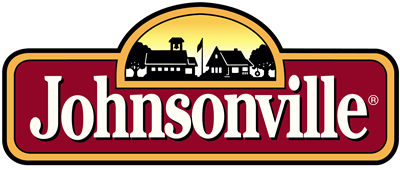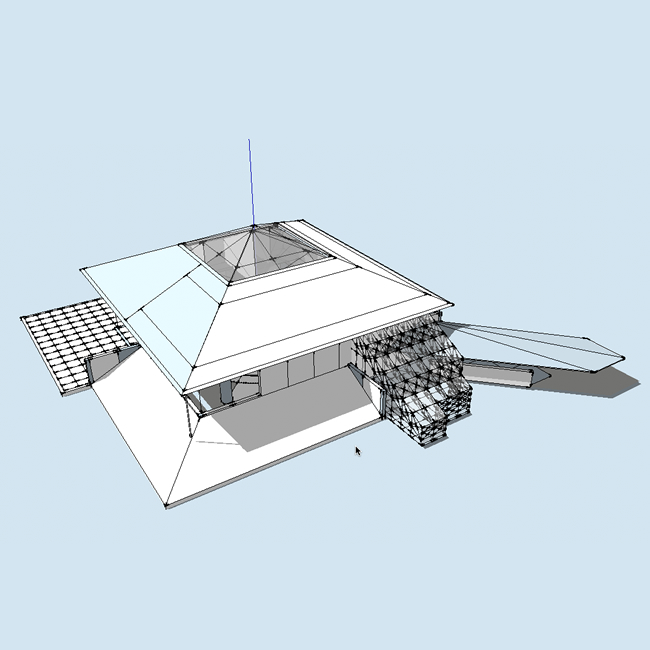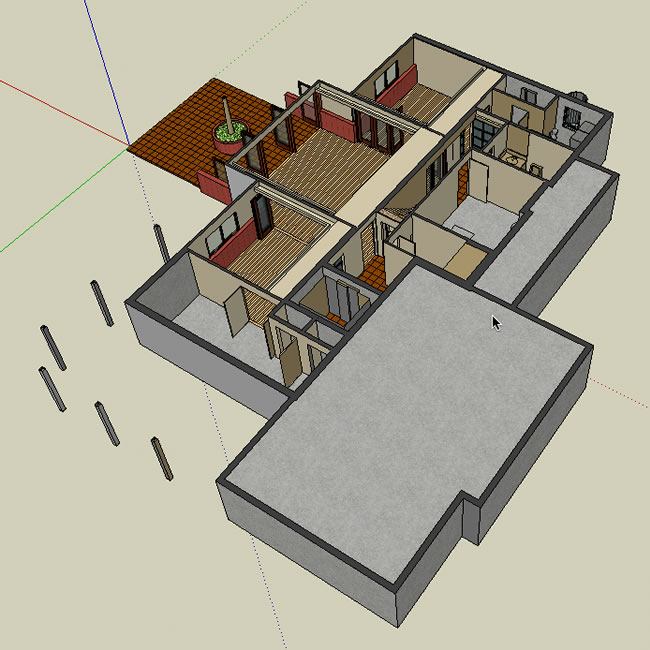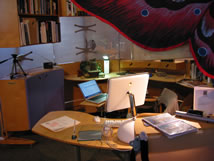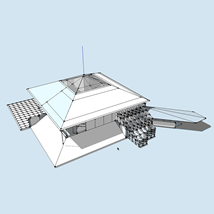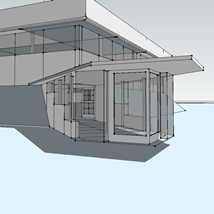PROJECT |
CATEGORY |
CRITERIA |
RANK |
NOTES |
|
|
| This is a sunny, open, optimistic environment which makes full use of the setting. Pavilion is directly aligned to the Palomares House facilitating future connectivity if the house is converted to a Hospitality Center. Pavilion is a high variety environment to match the fullness of it program requirements yet full of subtitle nuance. |
|
|
Brag-ability:
All of the designs have brag-ability each in a different way. Pavilion offers more scope and variety than the other designs with many spaces which have an entirely different sense of prospect and refuge and physical place-ness. If you “walk through” the environment from the Entry, Cybercafe, the vertical space of the radiant Room, the cozy upper level with it 360 degree view and onto the sunny terrace, this building has a place for every task, mood and moment of weather. |
|
|
| In dialog, the Johnsonville Team expressed the desire that the Commons environment be effective and “brag-able” yet not over done and appearing fancy nor ostentatious. Economy was stressed, as I understood it, not so much as the issue being money, per se, more in terms of not sending the wrong signals to Members and customers. |
|
| |
Symbol/Icon:
In shape, though smaller in mass, Pavilion echoes the Global Headquarters building. This is deliberate. Pavilion does, however, send a different set of symbols, less corporate and “global” more regional and relaxed. Pavilion stands “4 square” for a transformed future. Basic yet beautifully crafted, open and democratic, scanning, outreaching and sheltered, structured and variable, its exposed structure a metaphor of the problem solving process; built in the Mid-West by industrial means and pointing to new possibilities, Pavilion is an invention of a time and place an unique set of circumstances. |
|
|
Placeness:
The site for Pavilion and EarthWorks is about as good as it gets. Both employ the site in different ways. Pavilion orients to the NorthWest exposing its two story glass wall to both South and west exposures. Its earth berm reduces it profile in regard the house assuming a fair distance is established and adequate landscaping employed. |
|
|
Outreach-ability:
Of all the designs, including the Palomares House, Pavilion offers the greatest outreach-ability internally to Johnsonville members and externally to customers and community. It is a near perfect ValueWeb building environment. Of all the designs, matched only by EarthWorks, it can house the largest collaborative group activities. |
|
|
Political Fitness:
Building a temple to learning, innovation, creative collaboration, and personal human development, at this time in U.S. history is exactly the right kind of statement to make. All of the designs will do this. Pavilion makes the most explicit statement in its architecture. |
|
|
Economic Fitness:
This is an excellent time to build any building and more so to execute a more detailed and expensive one. People will want and appreciate work and have the time and patience - not pressed with a glut of work - to think through details and process. I believe as we move from “book” and historical numbers, we can make a very good buy with careful selection of contractors, suppliers and workers. Pavilion, because it it the most complex and expensive design, offers the greatest potential marginal utility by taking advantage of present conditions.
|
|
|
Cultural Fitness:
Pavilion is as much a culture making artifact as it is an expression of a culture. It is the expression of a future aspiration more than of a present reality. |
|
|
|
|
Budget:
Pavilion is double the desired budget for the project. The costs are mostly a factor of the features of the design: second level, extensive glass walls, CyberCafe, more complex truss system. The basic construction is the same for all three to-be-built options. |
|
|
|
Economy:
Over an extended period this building will be a good investment. Factors in favor of this are its solid and low maintenance construction, potential for promoting productivity, greenness and ultimate value as a piece of real estate. Mitigating factors are cost of money for relatively high capital costs, single use bias and remoteness form the Campus which in certain possible future conditions can become a liability.
|
|
|
Greenness:
All the new buildings are green. Pavilion has a much larger exposure of glass walls than the Palomares House or Inside. EarthWorks fall in between in this regard. Pavilion employs modern glass technology, orientation and projecting trellis screens to control sun gain. |
|
|
|
Build-Ability:
As with the other two new building concepts, Pavilion will build in an orderly, straight forward way. There is more of it and the details are somewhat more complex. Inside is essentially the same design, smaller, less complex without the external Cybercafe and two story glass walls. |
|
|
|
Expand-Ability; Transition:
The basic form factor, massing and size of this design does no lend itself to small scale, incremental expansion. A one story horizontal wing of sufficient proportion is an option. This can be done independently or in conjunction with a clone of the original structure. In any case, a relatively large investment will be required. In the the case of a significant expansion this will not be a negative. With gradual, smaller growth requirements, it will be. In the short and near term it is difficult to conceive of a reuse scenario given the location and overall configuration of the building. Its best use will remain a learning and collaborative design environment. |
|
|
Life-Cycle Cost of Ownership:
applying life-cycle analysis, the cost of ownership for all Three new building design will be very good. Pavilion and EarthWorks, being on the remote site thereby have an exit strategy if this becomes necessary or desirable. |
|
|
|
Expression:
Open and expansive and a down to earth solid, grounded aspect. Pavilion has a robust presence and the ability to provoke StrongMemory. |
|
|
|
Shelter:
All of the designs will keep the rain out and do a good job of managing the weather so this is not the point here. Pavilion, will do some amazing things with light, shade and shadow and this will provide an ongoing daily tapestry of lighting change and color migration. It will be like working in a forest. |
|
|
Arrangement:
high flexibility and potential for crafting the exact best place of each learning and design task, yet the more difficult space to learn to use well. By contrast, EarthWorks is much easier to use, requires fewer set ups to multitask yet, in the end, have less capacity for mystery and surprise. |
|
|
|
Support of Mission and learning:
Assuming future development to this building’s full potential, Pavilion has the highest probability of contributing high value to Johnsonville. This is so because of the sum of hundreds of small differences, which as a synergy, lets the building “escape to a higher order.” |
|
|
|
Connectivity:
at first, remoteness from the Campus (even from the Palomares House a familiar landmark) will be an issue. This will have to be a learned relationship. In time, RemotePresence™ technology and practices will be necessary to support the Johnsonville ValueWeb, world wide. |
|
|
Work Throughput:
up at the top, maybe a little behind EarthWorks and certainly more staff intensive to keep organized. |
|
|
Learning and Design Breakthroughs:
will be extraordinary after it is practiced. This is the most complex environment of the set and therefore will require more learning to get to it highest use. An experienced DesignShop® Team could come into this environment and provide an unbelievable experience up there with the best environments yet built. |
|
|
Johnsonville Member’s Development:
Up there at the highest as soon as they realize that this is “their” space and the remoteness issue is overcome. Pavilion will take a little longer to become part of the family, when it does the result will be supercharged. |
|
|
Support of Johnsonville ValueWeb:
on par with EarthWorks on the practical level ahead of all the options on the emotional, symbolic, iconic level. Properly developed and practiced, Pavilion can reach signature status with it stakeholders. This is not to say that the other options are weak in this regard. |
|
|
|
|
| A sense of flair combined with a down to earth practical layout that serves each function with total fidelity. This is a metaphor of what good design should do. EarthWorks is the most playful of the four designs. |
|
|
Brag-ability:
This design, when built, will be the least expected in its overall architectural effect and therefore the most surprising. It, in itself, speaks more to innovation and renewal even as it harks back to America’s hay days by employing symbols from 50s, 60s and 70s eras. This has interesting implications. |
|
|
| There once was a popular song of dubious ethics titled “Love the One You’re With!” As I work on all four of these designs I tend to love the one I am working on at the moment. Of course, I cheat a lot. Whenever I put a feature into one which gives it an “advantage,” I immediately add this - to the maximum degree possible - to the others. The CyberCafe came from the Palomares House and found its way to Pavilion and EarthWorks, as robust expressions of the idea, and as a distributed, intimate feature in Inside. The Earth berms, which offer greenery and insulation as well as establishing a parameter around the buildings, developed with Pavilion and became key to Inside and EarthWorks. Moving the Bathroom Units out into the berm started with EarthWorks, became a necessity to make Pavilion work and thereby became an enhancement of Inside. The Entry ritual of Pavilion found its way to Inside as the only “outing” of the box and in a mutated form to EarthWorks. The lookdown Office Balcony in Palomares became a main feature in Pavilion. A question from Cory about the profile of Pavilion - although I said I cold make it work, and can - nevertheless prompted me to design EarthWorks with its lower and more streamlined form factor. And so on. What has emerged from this design exercise is an architectural grammar that synthesis an economic way of building with the Common’s Program requirements to become an expression of The Johnsonville Way. A blending of philosophy, building, engineering, economics with learning and collaborative work processes to make an environment which not only works but also expresses what it does and its intent. |
|
| |
Symbol/Icon:
Although not dangerously so, EarthWorks is the most radical concept of all the options. It is a slightly retro design without appearing so. |
|
|
Placeness:
With it lower and lighter profile and use of earth berms, EarthWorks will be the easiest design to “marry” to the Palomares House. This will allow it to be placed closer to the exiting structure achieving two things: a more “courtyard” sense between the two structure and more space to expand the new building to the Southwest. |
|
|
Outreach-ability:
On par with Pavilion and perhaps somewhat more attractive to Johnsonville Members in the early stages of use. |
|
|
Political Fitness:
As with Pavilion, EarthWorks says the right thing only with a bit more humor, elan and direct reference that we, as a nation, and more importantly this region have been here before. It is a bold move in a worring time. It is not overdone, however, and this is important. This is not the time for monument building (if there is ever a time for it). |
|
|
Economic Fitness:
To me, it hits the nail on the head: More expensive than desired yet a no frills environment which efficiently does what it has to do with every penny building something which has a direct impact of user productivity. This is also an environment which can be upgraded over the years in a variety of ways from technology augmentation to the number of people it can serve and many degrees of additional amenities which can be added. |
|
|
Cultural Fitness:
While I not not anticipate resistance or conflict, I think that EarthWorks will ironically challenge, and ultimately extend, the johnsonville culture - and that of the surrounding region - more than the other designs. This design, although mostly traditional in modern design, has an edge that can be played well in developmental and ValueWeb programs. |
|
|
|
Budget:
Significant increase in desired but yet highly leverages the increased investment. Each dollar spent is directly buying space which directly increases ease of operation and throughput capability. Demand will not over run this facility too quickly and of all the designs EarthWorks can best support “crowding.” |
|
|
|
Economy:
Possibly the best trade off between investment and utility, this design may be the one which has “more bang for the buck” than all the rest. Its great support of the functions, flexibility and easy expandability contribute to this. |
|
|
Greenness:
On par with the others with a different sun strategy. EarthWorks largely turns its back on the Southern exposures with the exception of roof skylights which will be protected by roll down blankets. The rest of its glass is oriented Northward. The South West and east corners will get early and late sun and the CyberCafe receives South light the same as the Palomares House. EarthWorks is the best design for the mounting of significant solar collectors. While affording only a ten years return they can serve basic functions in brown-out or storm damage circumstances and contribute more as traditional energy costs increase. |
|
|
|
Build-Ability:
EarthWorks is the simplest to build of all the options. Like Inside, it has a simple structure and is placed on an open site offering easy access and space to organized materials. |
|
|
|
| |
Expand-Ability; Transition
EarthWorks can expand in small increments without interference to daily use. This can be done on line to the original layout and/or at 90 degrees on each or both ends. The inherent flexibility of the design make EarthWorks the most adaptable of all of the designs and thus less likely to become an economic dead end. |
|
|
Life-Cycle Cost of Ownership:
Certainly the best option in this regard. This building should have the lowest maintained costs of all. Its layout and panel wall system affords the lowest cost for adaptive use reconfiguration. |
|
|
|
Expression:
EarthWorks states its architectural premise in a single bold sweeping stroke. It is the most playful of the all the designs - and youthful. While looking forward, it has a slightly breezy 50s, 60s retro look to its structure and a simple modern glass, solid panel and landscaped “L.A.” interior - open and growth oriented. |
|
|
|
Shelter:
While extremely open on the horizontal plane, EarthWorks has a strong sense of shelter created by its lower (10 feet at soffit) roof line with its extensive overhangs. With the building large closed to the South and its linear layout, the eye will be “pulled” out to the river landscape. |
|
|
Arrangement:
By far, this will be the easiest environment to arrange, support multiple venues in real time and to administer. The closest to it is the Palomares House which has the same level of separated functionality without the same degree of openness and ability to “see” the entire work landscape in one glance. |
|
|
|
Support of Mission and learning:
A one-to-one fit with the physical program requirements. A challenging expression of the johnsonville way. Open for future growth. Beauty and excitement out of basic and long established means. |
|
|
|
| |
Connectivity:
On par with Pavilion. |
|
|
Work Throughput:
EarthWorks will facilitate the greatest through put of activities across all venues with the least amount of staffing overhead. |
|
|
Learning and Design Breakthroughs:
On par with Pavilion. |
|
|
Johnsonville Member’s Development:
On par with Pavilion. |
|
|
Support of Johnsonville ValueWeb:
On par with Pavilion except a lessor Iconic connection for the majority and a much stronger on for a smaller segment of the ValueWeb. |
|
|
|
|
| Inside is a functioning metaphor of “breaking out of the box” while accepting the reality of constraints.By turning inward, it totally makes and controls its own environment. Inside’s reference to nature is the natural lighting which streams in from the top of the structure and the 12 foot band of “Garden” at the inside parameter walls. |
|
|
Brag-ability:
The brag-ability here is how much is achieved with so little. Walking through the Entry into the main space is an immediate and total environmental transformation. In no time, those inside will “forget” where they are. The day-to-day busy Campus of business and manufacturing (a great thing in itself but a modality different than needed for learning and innovation) will rapidly “disappear” as this focused retreat environment works it magic. This matches the UniCredit effect in a much smaller simpler space. I am more than a little proud of this design. |
|
|
| The Johnsonville Team “commissioned” the new building challenge with the budget goal of getting the cost of the project in the $600,000 range. I have, from the beginning, been skeptical of this objective. Having done nearly 30 of these in a variety of conditions - some remodeling some built new, some large, some small - full service navCenters have a remarkable tendency to all cost in about the $1,000,000 range. A smaller, older structure requires more remodeling and almost the same WorkFurniture (which is determined by use-utility) than a larger space. A mundane “box” of no architectural distinction requires more Armature in older to have an expressive, focused space and the delivery of lighting and wiring. The best of all worlds is to build new so that there is not money spent on remedial efforts. Even so, there is a minimum point wherein all of the necessary functions can be reasonably served. Inside seeks this point. It is possible to “go down” more yet I do not recommend it given the Program requirements of this project. It seems like a big step up from the existing environment - and it is. However, the history of these facilities is that the demand they themselves create is usually greatly underestimated. |
|
| |
Symbol/Icon:
This is an intimate, compact space lit from above. It will not feel small or crowded yet it will feel like everything in it and every activity is connected and relevant to each other. Inside, you can see from end to end - the human energy will be strong and easily felt. Looking inward and recreating self in order to go “out” and do works is the message of this environment. The building is a simple and direct expression of the core mission. |
|
|
Placeness:
On Campus this will be a retreat and “strange-attractor” - people will come here not only for scheduled, formal learning and design activities; they will come for personal reasons: to think, reflect, and study. These are important activities not recognized sufficiently in the modern workplace. The architecture of the typical work environment embeds a set of commands to not take personal time to think and recreate. |
|
|
Outreach-ability:
Inside is right there and will have the best accessibility for Johnsonville Members and will likely to be the only solution in the short terms which they will use at lunch times and for short visits coming and going to work. This fulfills one of the major program elements directly. The CyberCafe “inside” will be effective however not as separated as provided by the other designs. More intimate, less a place of its own. Properly placed on Campus, Inside can serve the Johnsonville Customer base will This calls for easy access to the Global Building and its amenities. It will do well with community initiatives however, this will require that other activities are at a minimum. This suggests more of a weekend, evening venue. Very adequate yet weighted less than with Pavilion or EarthWorks. |
|
|
Political Fitness:
Times like the present are the best times to make capital investments. The price is right. it sends a good message to the market. It puts new capability in place in anticipation of future growth. It leave the organization free from distractions to take profit in the good times.This is true for all four options. Unless, Inside is actually the most capacity Johnsonville will need for some time, this level of investment - assuming cash is available - may be too conservative and a missed opportunity. |
|
|
Economic Fitness:
See above. |
|
|
Cultural Fitness:
Inside sends a different kind of message about Johnsonville’s aspirations and view of the future. It is a more modest statement than Pavilion or EarthWorks. It is not an easy assessment which of the these two world views are the best thing to “say” at this time and place. Careful though should be given to this. If the strategy is aggressive expansion, then it may be better to choose one of the other options or be ready to re-purpose this facility and build another one in the near future. If the strategy is consolidation and/or slow growth with a more cautionary attitude, then Inside is the better meme. |
|
|
|
Budget:
The best budget option. |
|
|
|
| |
Economy:
At the top for economy assuming an effective re-use application if-when the facility become too small and/or when the Commons is developed with the Hospitality Center. |
|
|
Greenness:
The best energy strategy. |
|
|
|
Build-Ability:
The easiest and fastest to build. Takes advantage of existing infrastructure. |
|
|
|
| |
Expand-Ability; Transition
Extremely good assuming it is designed for a likely reuse that will be required in the near future. |
|
|
Life-Cycle Cost of Ownership:
Low assuming reuse-ability. Will require greater staffing than EarthWorks to get maximum throughput, less than Pavilion and about on par with the Palomares House. |
|
|
|
Expression:
It would be easy to underestimate the architectural qualities of this work. It is different than Pavilion and EarthWorks, and works another thematic path, however, it is not in any way inferior to them in human qualities or architectural interest. |
|
|
|
| |
Shelter:
Technically, no challenges. Inside will have a strong sense of place, retreat-ness and a “own world” kind of sheltering. |
|
|
Arrangement:
Rational. Each function has it space: Collaboration and large group work in the center. “Offices” in the right hand corner. Learning Rooms (which can divide in two and also open to the collaborate space, at the top (relative to the Entry) and left hand corner. CyberCafe, distributed throughout the surrounding green band. This is compact layout yet will not feel such. The trade-off is only in multitasking with the bias toward the Learning Rooms with a reduction in the collaborative spaces (unless the set up is reversed). |
|
|
|
Support of Mission and learning:
More than adequate with a bias towards internal activities. |
|
|
|
| |
Connectivity:
Perhaps the best for Members and internal day-to-day activities. Less for extended ValueWeb. |
|
|
Work Throughput:
Inside is a highly productive space. Its throughput will be a little than the Palomares House with a few more constraints in terms of multi-tasking abilities. The collaborative design spaces will be on the smaller side, a better shape than the House areas and highly effective for groups up to 50. Larger groups can be served if the space is reset for that purpose (about a two hour task) and other activities greatly constrained during the period of an event. While the lowest in work through put because of its more limited multitasking capability, it is important to know this judgment is by navCenter standards. Compared to typical work spaces, Inside will be a high achiever. This will not be an issue in the beginning. However, as demand increases, even after learning how to achieve maximum throughput (this usually takes a year), the ratios of multitasking compared to the other options will be about: Palomares House, 10% less, Pavilion, 35% less, EarthWorks, better than 50% less. |
|
|
Learning and Design Breakthroughs:
Actually this design might be surprisingly good for breakthrough thinking and work. It has an intimate “cloistered” feel to it which supports peaceful, contemplative thinking and concentration.
|
|
|
Johnsonville Member’s Development:
I think Inside will quickly become a favored place for Johnsonville Members. It is less (initially) intimidating than the other designs and has a low threshold of accessibility. Being on campus make it more easily “theirs.” This aids development, perhaps more than the others even given its lower utility, in the sense that it promotes more frequent use. |
|
|
Support of Johnsonville ValueWeb:
High for Johnsonville Members; Good for Customers if the connectivity to the Global Headquarters is done well; fail for community as its “on Campus” setting makes it less open and neutral.
|
|
|
|
|
| An exemplary example of re-use with a great deal of utility in a small, existing, foot print, providing an “at home” sensibility. |
|
|
Brag-ability:
It is with this design that the “brag-ability” notion came up so this stands as a benchmark. The new buildings are certainly more exciting buildings structurally and in space and mass, however, the quality of the interior finish of the Palomares House will stand out. Other than Pavilion, this design has the most spectacular CyberCafe - an important element of the Program. |
|
|
|
| |
Symbol/Icon:
The Palomares House has its own thing going for it along with a tad of family history. The design, I think, pulled this out very well. It certainly can be a good expression of Johnsonville’s past and present aspirations yet may fall short in terms of seeking a proper level of future ambition. Still, I like it. |
|
|
Placeness:
Excellent assuming that proper parking is provided and a fair weather pathway is provided back to and from the campus. This should be part of a larger project to better tie the entire campus together and create recreational spaces. |
|
|
Outreach-ability:
As a base line and by normal standards, the Palomares House will work well in terms of outreach. Of the four options, it will be the less effective over the long run. Again, as an Hospitality Center connected to the Johnsonville Commons, would be the best use of this building. |
|
|
Political Fitness:
locally, this project will be fine. It does not make the larger statement that Pavilion will. Nor does it have the playfulness of EarthWorks or the sober focus of Inside. It does do its own thing in a workmanship-like way and certainly will not make negative waves. |
|
|
Economic Fitness:
Maybe not the best economics in the end compared to applying the appropriate design to converting this building into a Hospitality Center connected to the navCenter Commons. |
|
|
Cultural Fitness:
An easy fit in the short term, yet may impose unknown-from-here limits in a few years. There is an interesting and very deep dynamic between physical place and the development of culture. In a transformational time, this can be complex. the new buildings will be much easier to evolve than the House. |
|
|
|
Budget:
On the higher end in terms of total cost yet near the lower in terms of new cash out required to get to a usable space. This project can be staged and the level of finish can be varied from section to section of the space. The purchase cost, while part of the total cost, presumably is not a factor with present cash flow. |
|
|
|
| |
Economy:
This is a mixed bag and a judgment call. It is on the margin as to if it is a good long term investment. lacking other options, however, there is not question that it is a viable project which, properly employed, can need multiple returns in short order. |
|
|
Greenness:
As a building, the Palomares House can never be as green as something built today by green standards. However, reuse is always a green plus as much of the impact of new construction is eliminated. This is, of course mitigated by the substantial construction which will use traditional materials and not require the level of manufacturing that the new building will employ. There are a number of balancing trade offs here. |
|
|
|
Build-Ability:
Nothing all that difficult yet complex for it size. The end results will be very good yet getting there involves some careful and in some places difficult work. This will not be a modern building process like the new buildings. |
|
|
|
| |
Expand-Ability; Transition
The expandability strategy is to build a enclose walkway to a new building like Pavilion or EarthWorks. To put the House “back” to what it was is not feasible. To covert it to a Hospitality Center after being converted to a NavCenter is possible yet expensive and backwards. To make it into an office I think is to send mixed messages. Transitioning, therefore is a bit of a trap. |
|
|
Life-Cycle Cost of Ownership:
The highest over the long run, I expect. I have not analyzed this but it is certainly true by size if not absolutely. |
|
|
|
Expression:
To bring this building up to an authentic expression of what its new mission is and to the traditions of the region, extensive refinishing of its cladding, facia details and materials used will have to be done over time. The interior and exterior detailing, roofing and materials can be brought “back” to an Arts and Craft, Bungalow, Prairie School sensibility. This approach will fit nicely with the proposed modifications. The house should keep itsresidential feel yet not look like a misfit, poorly adapted house. Lanscaping, upgrading the materails, adding some overhang and trellises, bringing more continuity to the parts while stressing the building’s massing can achieve an excellent result with historic precedent (The grand “shingle-style” 19th Century summer family retreats). |
|
|
| There is the story the duckling hatched by a swan (actually I think it was chick by an elephant) and the baby popped out and said “are you my mother?” We do not know for sure what the swan, or elephant thought. Because the Palomares House was my first design in this exercise, I still am asking “are you my baby?” It took a lot to get the result and there is a part of me that still wants to do it. Even the attraction and relative ease of building properly from the ground up tends to cloud my objectivity regarding the House and this made the work of designing the three new options more difficult. I still think that this is a viable option even considering the build complexities and the cost structure. It is at least, a base line upon which to judge the other investments and on a cash flow basis, the cost of the house is paid for taking a significant amount of cash out of the project moving forward. That said, the best result in my mind is a new building adjacent to a redone House as a Hospitality Center. I hope we can get there some day. |
|
| |
Shelter:
With the work prescribed in the present plan and a follow on long term development process this property can become a place expressing a real sense of shelter and purposeful comfort. Opening the plan, as the new design does, allows the House to embrace the landscape is a much greater degree than it does today. |
|
|
Arrangement:
The arrangement of this re-purposed design worked our remarkably well. these are good spaces with the ability to support many venues at once. It was not easy to get the new design, without going considerably larger to match the potential out put of the House. I did a fourth design, which was three main and two half levels stacked on top of one another and it worked fine - too expensive, however. |
|
|
|
Support of Mission and learning:
High yet ultimately limited by size. |
|
|
|
| |
Connectivity:
For Members, not as high as Inside, yet a bit more than for Pavilion or EarthWorks. For corporate partners and community is will be the other way around with the exception of INside which can be sited to work in very close harmony with the Global Headquarters building. |
|
|
Work Throughput:
About equal to Inside depending on venue with a more fulsome CyberCafe. Equal to pavilion in the beginning but ultimately surpassed. EarthWorks is the Palomares House spread out and made efficient. It will surpass the house from the beginning. It must be recognized, however, even though the new building will do it better, the House is competitive in through put ability to a remarkable degree. |
|
|
Learning and Design Breakthroughs:
Good yet limiting, compared to Pavilion and EarthWorks, with the kinds of exercises the environment will support. The impact of these limits is not likely to be significant for a few years. |
|
|
Johnsonville Member’s Development:
Excellent in the beginning, ultimately limiting. |
|
|
Support of Johnsonville ValueWeb:
Equal to Inside and in some ways better. Falls behind Pavilion and EarthWorks over longer term. |
|
|
PROJECT |
CATEGORY |
CRITERIA |
RANK |
NOTES |
